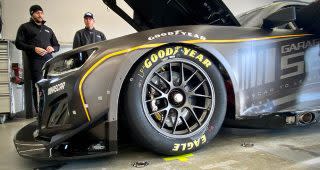Officials monitoring Garage 56 project for potential Next Gen advancements

The Garage 56 project is building off NASCAR’s Next Gen platform, but with more freedom for modifications as it readies for a proposed Le Mans run next June. But the program is being closely monitored for potential advancements that could make their way to the NASCAR Cup Series.
NASCAR CEO Jim France, vice chairman Mike Helton and IMSA president John Doonan were among the invested observers during last week’s two-day session at the Virginia International Raceway road course, where the latest edition of the Le Mans test stocker hit the track.
RELATED: Garage 56 VIR test recap | Test days in photos
Steve O’Donnell, NASCAR Chief Operating Officer, indicated last week on the “Stacking Pennies” podcast that wind-tunnel findings from the Chevrolet Camaro ZL1 test car could be given a trial run in a Next Gen test at Richmond Raceway.
“I think there‘s gonna be some good things,” O’Donnell said. “At least from what we‘ve seen already in the wind tunnel and a lot of the sim data, it looks really good in terms of getting rid of some of the challenges as we‘ve seen, particularly on the short tracks.”
Hendrick Motorsports’ Greg Ives, who joined the Garage 56 effort after the Cup Series season, said that the nature of the special Le Mans entry has given the team a bigger window to develop the car outside of the Cup Series rule-book structure. That spirit of innovation was most visibly evident this week with the test car’s advanced aerodynamic additions — dive planes on the front and rear fenders, a larger front splitter and a different rear diffuser.
NASCAR has experimented with more robust aero options before, adding dive planes to the sixth-generation Cup Series car’s body panels in a 2014 test at Michigan International Speedway. Those aero enhancements were among the six configurations tested back then but did not appear in competition.
Ives said that making similar aerodynamic measures seemed unlikely as the NASCAR Cup Series heads toward year two with the Next Gen racer, but that gains could be found when it comes to durability of the car’s systems. More versatility, Ives said, could attract more interest from outside NASCAR’s traditional following.
“There’s always transition, especially when the majority of the car is very similar,” Ives said. “I think some of the add-on aerodynamic pieces to be able to adjust and change balance, probably not something we’re going to look at, but maybe. You have such a huge dynamic of race tracks on the NASCAR Cup circuit, maybe you see that variance, but some of the mechanical items, definitely you can see even with the mechanical issues that we’re going through in just such a different environment, to be able to apply some of that to make the cars a little bit more reliable from an engine, fuel systems, oil systems and electrical standpoint.
“I mean, it’s hard because you can be a little bit more creative in this environment without the rules. NASCAR’s here, Goodyear’s here, Dallara’s here, the heads of NASCAR and IMSA and there’s a lot of very important people, but also very passionate people about racing to put a better product on the race track so anything’s possible. Even other OEM reps are here, so collectively we can work through and create a better product on Sunday, but maybe make people outside of the standard NASCAR Cup Series a little more excited about what the versatility of this car could be.”

 Yahoo Sports
Yahoo Sports 